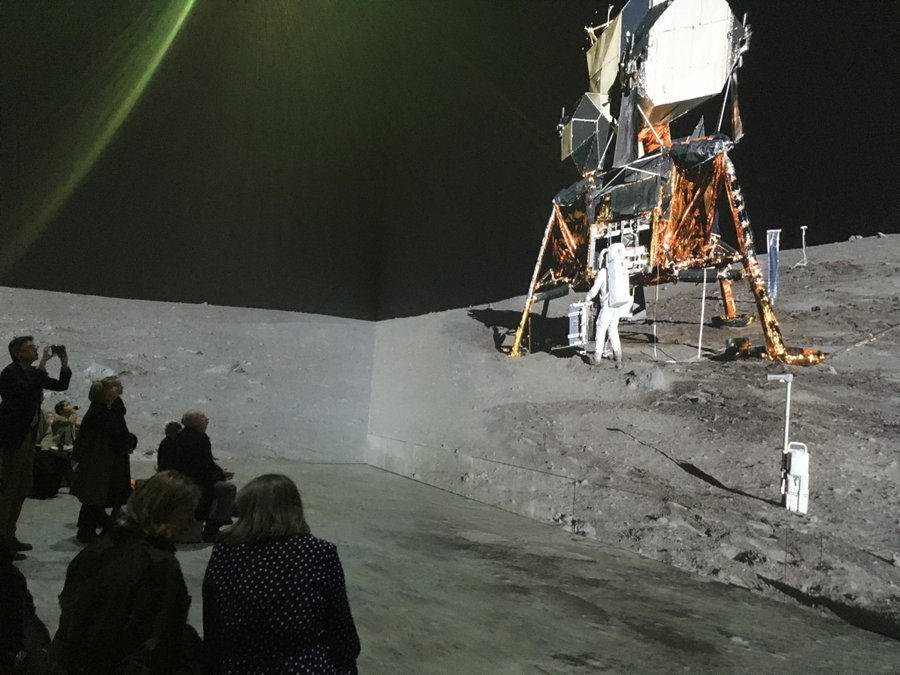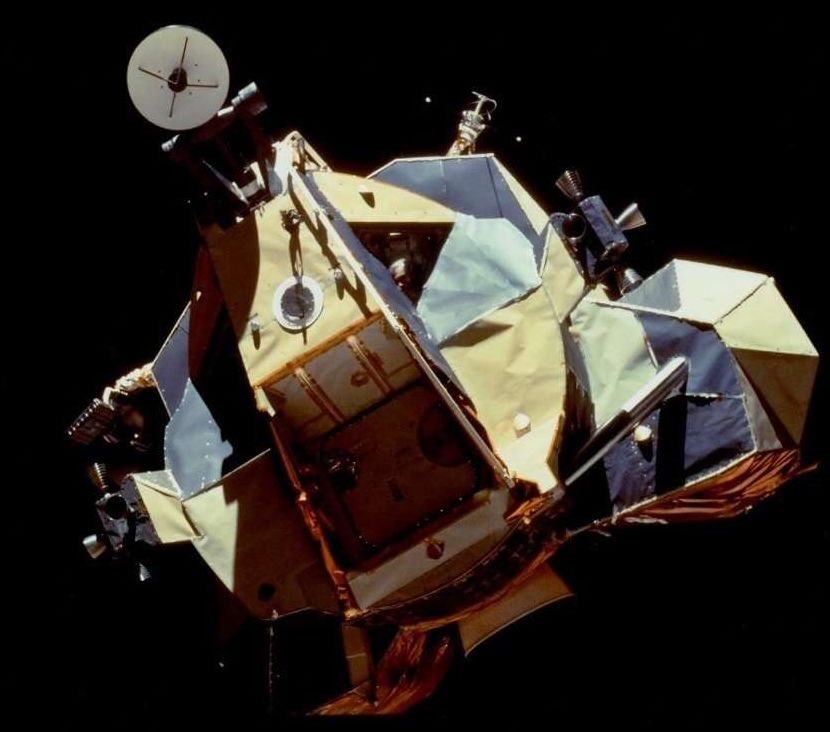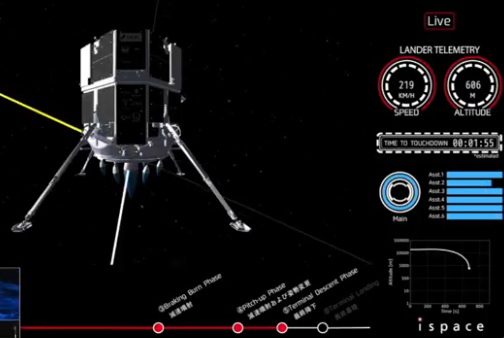David Todd, Head of Space Content at Seradata, was invited to the opening night of The Moonwalkers: A Journey With Tom Hanks, a new audio visual show at The Lightroom in London.
It is said that each generation thinks that its music is the best and that they invented sex. And the same could be said for high technology. With increasing interest in current and future spaceflight from younger generations, Gen Z et al, this is a good time to remind them of previous generations’ achievements. One way of doing this is to use wonderful images and sounds produced by NASA’s glorious, manned Apollo programme of the 1960s and early 1970s.
By the way, we use the term “manned” deliberately because women and ethnic minorities were frozen out of the glory. More on that later. Nevertheless, while it might not have been diverse, the Apollo programme inspired many, including actor and writer Tom Hanks. Alongside British co-writer and documentary maker Chris Riley, the pair have produced a 50-minute documentary/audio visual immersive show on the Apollo Moon landings at London’s specialist Lightroom theatre.

Tom Hanks at the opening night of Moonwalkers at London’s Lightroom. Courtesy: Seradata/David Todd
The content
The audio-visual show starts with some history, using film clips, photos and technical drawings about how Apollo came to be. Most significantly, President John F. Kennedy is shown making his famous Rice University speech committing the nation to landing its astronauts on the Moon. The show then moves on towards Saturn V’s beautiful launch, with the walls of the theatre showing it on different multi-screens before going on to the hazardous first landing: Apollo 11. When the red light 1202 alarm comes up, it demonstrates the panic that the astronauts must have felt. Nevertheless, the landing carried on, followed by grainy TV images of Neil Armstrong’s first step and Armstrong’s lovely Hasselblad camera photos of Buzz Aldrin on the Moon.

Feels like you are there: the audience is part surrounded by the surface of the Moon – even if the lower access/ventilation panel seam somewhat breaks the spell. Courtesy: Seradata/David Todd
Hanks narrates the story in his own charming way – and he makes it personal, describing how he used to float underwater in a pool, using a hose to breath while imagining himself floating in space. As a childhood space fan, he explains how irritated he got with his parents’ nonchalant disinterest as humans walked on the Moon during the later Apollo flights. And that is where this show scores. It goes into more detail about the later Moon landings, explaining their landing sites including, of course, the use of that first electric lunar automobile, the lunar rover.

British comedian and space fan John Bishop meets the Artemis 2 astronauts. Courtesy: Seradata/David Todd
Interwoven into the story are statements from Artemis 2 mission astronauts, who also attended the first night of the show (along with several celebrities including the artist David Hockney). They will soon be the first astronauts to fly around the Moon since 1972. In the show, they note their own childhoods and what inspires them today. Apart from their main mission – a round-the-moon test precursor to later landings – Artemis 2 has a secondary goal: to make up for the discrimination in NASA’s past. It does this by having a more diverse crew with a man of Afro-Caribbean descent, Victor Glover, and a female astronaut, Christina Koch. These weren’t just diversity hires: both have long and accomplished astronaut experience. Wedged in between these two are NASA astronaut Commander Reid Wiseman and Canadian astronaut Jeremy Hansen.
Charming and talented as these movie-star-looking dudes obviously are, you couldn’t help wondering if they might be the “handsome hires”. It was alleged that Armstrong’s good looks got him the vote over Buzz Aldrin to be first to set foot on the Moon. However, whatever the Artemis 2 crew look like, all of them are extraordinarily brave, as space can be a dangerous place. This writer wishes them Godspeed.
But enough of that, forgetting the history and diversity politics, it is the images and the sound that dominate in this audio-visual space extravaganza. Your correspondent particularly liked the large projection of the crater-crinkled Moon as its phase changed.
So how good is the show?

Feel the rumble in the Jungle (well at London’s Lightroom) as Saturn V lifts off. Courtesy: Seradata/David Todd
It’s pretty marvellous. The rumble of the beautiful rising Saturn V rocket sent vibrations through the body (anyone who has been close to a rocket launch knows this is true). The panoramic lunar surface imagery using “surround-IMAX” really does make you believe you are there. And underneath it all is Tom Hanks’ and Chris Riley’s story. They deserve plaudits for the writing, and Hanks’ narration is exemplary (he got your correspondent’s personal congratulations for this on the opening night). The projection of the high-resolution photography was also good. Even if some of the source NASA TV and film footage really isn’t up to hi-definition projection, most of it just wows.
While many space cadets and astronaut aficionados will have seen much of this footage and imagery before – either on TV documentaries (e.g. the mini-series ‘From the Earth to the Moon’) – or on specialist audio-visual shows such as at the IMAX at Kennedy Space Centre, there is always something new to learn: like realising that Gene Cernan’s face can be seen in the window of the Apollo 17 ascent module as it came into dock, or hearing how the astronauts really enjoyed throwing things for hundreds of yards in the one-sixth gravity environment.

Gene Cernan’s face is just visible in triangular right hand window of the Apollo 17 ascent module. Courtesy: NASA
What’s missing?
In being about “Moonlandings” there is little mention of Apollo 8’s significant round-the-Moon trip, a key to the later Apollo landings. Nor was there much mention of the Apollo 13 failure, albeit that Hanks’ movie starring role in that magnificent rescue story has probably said enough. Multi-screen projection in a square sided room means you can only see one or two sides at a time, leaving you with a fear that you are missing something.
Conclusion: A marvellous reminder…and an appetizer for things to come
This is a marvellous show for the uninitiated, returning you to the days of the glorious Apollo Moon landings. With human spaceflight returning to the Moon via the Artemis human lunar exploration programme, this was both a reminder and an ideal appetizer. As Tom Hanks put it in his address: “It is not about what we have done…it’s about what we are doing.” In the meantime, this show will make you think that you are on the Moon – or at least make you want to visit it, perhaps one day as a tourist. And even if you are an old-stager ‘space cadet’ who has seen it all before…like this writer, you will probably learn something new from a viewing.
Seradata rating: 9 out of 10 (Recommended)
Post Script: Here are some comments from some of the celebrities who went to the first night of the show (spoiler alert: they liked it).
Get a glimpse of last week's excitement at the opening of The Moonwalkers: A Journey with Tom Hanks.
It was a pleasure to be joined by narrator and co-writer Tom Hanks for an opening speech… pic.twitter.com/1WaKAdgJxe
— Lightroom (@_LightRoomLDN) December 12, 2023
And here is the reaction of revered artist David Hockney (who has just had a show at the Lightroom himself)
#OTD 13th Dec 1972.
Our last mission to the Moon, Apollo 17, EVA-2. The crew visited Shorty Crater.
The great David Hockney's reaction as the full Apollo Remastered panorama was revealed at the @_LightRoomLDN opening of #TheMoonwalkers last week was priceless.
Music: @annenikitin pic.twitter.com/NTSqkrOsZG— Andy Saunders – Apollo Remastered (@AndySaunders_1) December 13, 2023






